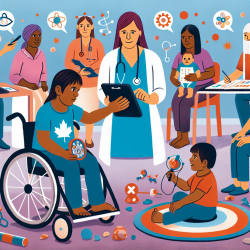Introduction
In the ever-evolving field of speech-language pathology, understanding the intricacies of sensory processing can significantly enhance therapeutic outcomes for children. A recent study titled "Human olfactory-auditory integration requires phase synchrony between sensory cortices" sheds light on the neural mechanisms underlying multisensory integration, specifically how the human brain integrates olfactory and auditory cues. This research provides valuable insights that can be applied to improve therapeutic practices and outcomes for children.
Understanding the Research
The study utilized intracranial electroencephalography (iEEG) to explore the neural activity in auditory and olfactory cortices during an auditory-olfactory matching task. The researchers discovered that spoken cues trigger phase locking between low-frequency oscillations in these cortices before the arrival of an odor. This phase synchrony was observed only when participants responded correctly to the task, indicating its crucial role in successful sensory integration.
Furthermore, the study found that low-frequency oscillations in both auditory and olfactory cortical areas couple with high-frequency oscillations in the olfactory cortex during correct trials. These findings suggest that phase synchrony is a fundamental mechanism for integrating cross-modal odor processing, highlighting the importance of primary olfactory cortical areas in multisensory integration.
Implications for Practitioners
For practitioners in the field of speech-language pathology, these findings underscore the importance of incorporating multisensory integration strategies into therapeutic interventions. Here are some practical applications:
- Incorporate Multisensory Cues: Use auditory and olfactory cues together in therapy sessions to enhance sensory integration and improve outcomes. For example, pairing specific sounds with scents can help children better associate and process sensory information.
- Focus on Phase Synchrony: Design activities that promote phase synchrony between sensory modalities. This could involve exercises that require children to match sounds with corresponding scents, enhancing their ability to integrate sensory information.
- Monitor and Adjust: Regularly assess the child's response to multisensory integration tasks and adjust strategies accordingly. This ensures that interventions are tailored to the child's unique sensory processing needs.
Encouraging Further Research
While this study provides a foundational understanding of olfactory-auditory integration, there is still much to explore. Practitioners are encouraged to engage in further research to deepen their understanding of multisensory integration and its impact on child development. Collaborating with researchers and participating in studies can provide valuable insights that enhance therapeutic practices.
Conclusion
The integration of olfactory and auditory cues through phase synchrony offers a promising avenue for improving therapeutic outcomes in children. By incorporating these insights into practice, speech-language pathologists can enhance their interventions and support better developmental outcomes. To delve deeper into the original research, please follow this link: Human olfactory-auditory integration requires phase synchrony between sensory cortices.










